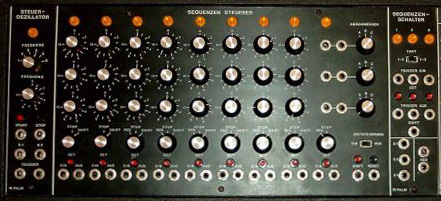The PPG 100 Series |
|
|
|
The first thing most people notice
about the 100 Series modulars is just how much they look
like a Moog! This is not just a coincidence, as they
were a spin-off from Wolfgang's involvement with
servicing modular systems.
One thing of note is the inclusion of the sequential switching section, a separate module in Moog's system (962) |
|
PPG 100 Series Sequencer |
|
|
The sequencer module differs from its 300 Series successor most obviously by the row of amber step indicators above the CV pots. On closer inspection you'll notice that the panel legend is in German too! |
|
|
|
Moog 960 Sequencer |
|
Close-up of PPG Series 100 Sequencer |
||
|
|
|
|
|
A single "step" |
The output section |
Sequential Switch (note the different switch from the above system) |
|
(note the different switch style from the above system) |
||
| One interesting note about the PPG 100 series modular systems is that several modules were "grouped" onto larger panels. One particular example is the VCOs. In Moog systems, the driver (901A/921A) and the slave VCOs (901B/921B) are discrete modules. In the 100 system, the driver and three VCOs are included on one larger panel, though made to look like individual modules! The VCOs are labelled 1-3 and the advantage to them being on one panel is the integration of several functions that would otherwise require patching. | Much like the Moog 900 series, the PPG 100 system included
both full height and partial modules. Oddly, the partial
height modules were sometimes included in rows alongside the
full modules with a filler strip below them. The 100 Series used metal threaded jacks, whilst the later 300 Series system used plastic nosed types like the RSF modular systems. |
As is apparent, the panel legends for the PPG 100 system
are all in German, though this would not present much
impedance to anyone familiar with a Moog modular on the
whole. The system also featured a number of instances of the classic ITT Schadow mechanical "eye" switches which required no power but give a very clear indication of their status, something often missing on push-buttons! |
